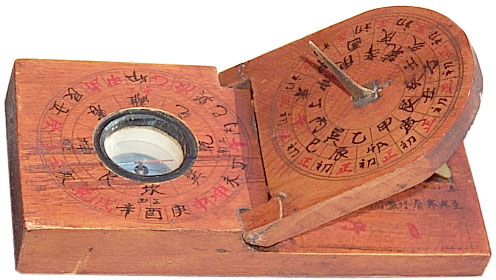

This is a Combination Chinese compass (Wiki - Luopan) and Sundial. This design is thousands of years old. Many of the markings are based on the I Ching. There are compass only versions of this called Bau Gua, Ba Gua, Bagua, Lo Pan, etc. used in the compass school of Feng Shui. Many of the concepts of the school of Feng Shui are aligned with the concepts in "The Pattern Language" by Christopher Alexander et. al. ISBN: 0195019199. See my comments on Feng Shui and the Pattern Language.
The wooden base contains a compass and an elevation scale with 13 notches for the sundial. The top sundial has a folding Gnomon on the top surface and on the bottom there is a hinged support that can be placed in one of the 13 elevation notches.The compass appears to have a ball joint at the base allowing the needle to tip, maybe not as much as the local magnetic field vertical angle, but enough that the compass works over a very wide range of Latitudes. The reason it does not need to have the full magnetic field vertical angle is that there is probably a weight under the ball that tries to keep the needle horizontal.
View Showing the Compass and Sundial Elevation Scale (Sundial has been removed):

View showing only the Sun Dial removed from base:

When the sundial is at the lowest notch (#1position) the face of the dial is raised 34.8 degrees.
2. Sundials in China - A brief note
It appears mine is a replica of Song Dynasty (about 1000 - 1400 A.D.) Chinese portable sundial made of wood.
The National Watch and Clock Museum - Asian Horology Gallery - Asian Gallery -
Adler Planetarium & Astronomy Museum - Heavenly Reflections Exhibit - shows this one as a Needham Type-B 19th century
Where does the Yin Yang Symbol come from?
Heavenly Mathematics: Cultural Astronomy - many interesting links
"Granting the Seasons: The Chinese Astronomical Reform of 1280, With a Study of Its Many Dimensions and a Translation of its Records (Sources and ... History of Mathematics and Physical Sciences)" by Nathan Sivin - on order 24 July 2011
Back to Brooke's Products
for Sale, Sundials,
Surveying,, Home page
page created 6 Feb 2003.